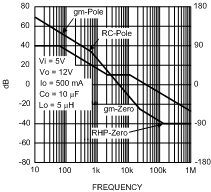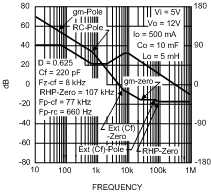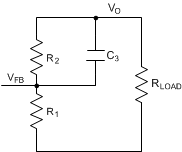ZHCSHW2I June 2007 – September 2018 LM2735
PRODUCTION DATA.
- 1 特性
- 2 应用
- 3 说明
- 4 修订历史记录
- 5 Pin Configuration and Functions
- 6 Specifications
- 7 Detailed Description
-
8 Application and Implementation
- 8.1 Application Information
- 8.2
Typical Applications
- 8.2.1 LM2735X SOT-23 Design Example 1
- 8.2.2 LM2735Y SOT-23 Design Example 2
- 8.2.3 LM2735X WSON Design Example 3
- 8.2.4 LM2735Y WSON Design Example 4
- 8.2.5 LM2735Y MSOP-PowerPAD Design Example 5
- 8.2.6 LM2735X SOT-23 Design Example 6
- 8.2.7 LM2735Y SOT-23 Design Example 7
- 8.2.8 LM2735X SOT-23 Design Example 8
- 8.2.9 LM2735Y SOT-23 Design Example 9
- 8.2.10 LM2735X WSON Design Example 10
- 8.2.11 LM2735Y WSON Design Example 11
- 8.2.12 LM2735X WSON SEPIC Design Example 12
- 8.2.13 LM2735Y MSOP-PowerPAD SEPIC Design Example 13
- 8.2.14 LM2735X SOT-23 LED Design Example 14
- 8.2.15 LM2735Y WSON FlyBack Design Example 15
- 8.2.16 LM2735X SOT-23 LED Design Example 16 VRAIL > 5.5 V Application
- 8.2.17 LM2735X SOT-23 LED Design Example 17 Two-Input Voltage Rail Application
- 8.2.18 SEPIC Converter
- 9 Power Supply Recommendations
- 10Layout
- 11器件和文档支持
- 12机械、封装和可订购信息
封装选项
机械数据 (封装 | 引脚)
散热焊盘机械数据 (封装 | 引脚)
- DGN|8
订购信息
7.3.4 Compensation
The LM2735 uses constant-frequency peak current mode control. This mode of control allows for a simple external compensation scheme that can be optimized for each application. A complicated mathematical analysis can be completed to fully explain the internal and external compensation of the LM2735, but for simplicity, a graphical approach with simple equations will be used. Below is a Gain and Phase plot of a LM2735 that produces a 12-V output from a 5-V input voltage. The Bode plot shows the total loop Gain and Phase without external compensation.
 Figure 15. LM2735 Without External Compensation
Figure 15. LM2735 Without External Compensation One can see that the crossover frequency is fine, but the phase margin at 0 dB is very low (22°). A zero can be placed just above the crossover frequency so that the phase margin will be bumped up to a minimum of 45°. Below is the same application with a zero added at 8 kHz.
 Figure 16. LM2735 With External Compensation
Figure 16. LM2735 With External Compensation The simplest method to determine the compensation component value is as follows.
Set the output voltage with the following equation.

where
- R1 is the bottom resistor and R2 is the resistor tied to the output voltage.
The next step is to calculate the value of C3. The internal compensation has been designed so that when a zero is added from 5 kHz to 10 kHz, the converter will have good transient response with plenty of phase margin for all input and output voltage combinations.

Lower output voltages will have the zero set closer to 10 kHz, and higher output voltages will usually have the zero set closer to 5 kHz. TI recommends obtaining a Gain and Phase plot for your actual application. See Application and Implementation to obtain examples of working applications and the associated component values.
Pole at origin due to internal GM amplifier:
Pole due to output load and capacitor:

This equation only determines the frequency of the pole for perfect current mode control (CMC). That is, it doesn’t take into account the additional internal artificial ramp that is added to the current signal for stability reasons. By adding artificial ramp, you begin to move away from CMC to voltage mode control (VMC). The artifact is that the pole due to the output load and output capacitor will actually be slightly higher in frequency than calculated. In this example, it is calculated at 650 Hz, but in reality, it is around 1 kHz.
The zero created with capacitor C3 & resistor R2:
 Figure 17. Setting External Pole-Zero
Figure 17. Setting External Pole-Zero 
There is an associated pole with the zero that was created in the above equation.

It is always higher in frequency than the zero.
A right-half plane zero (RHPZ) is inherent to all boost converters. One must remember that the gain associated with a right-half plane zero increases at 20 dB per decade, but the phase decreases by 45° per decade. For most applications there is little concern with the RHPZ due to the fact that the frequency at which it shows up is well beyond crossover, and has little to no effect on loop stability. One must be concerned with this condition for large inductor values and high output currents.

There are miscellaneous poles and zeros associated with parasitics internal to the LM2735, external components, and the PCB. They are located well over the crossover frequency, and for simplicity are not discussed.